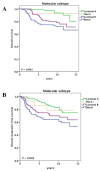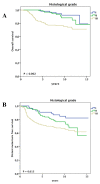Impact of established prognostic factors and molecular subtype in very young breast cancer patients: pooled analysis of four EORTC randomized controlled trials
- PMID: 21699739
- PMCID: PMC3218957
- DOI: 10.1186/bcr2908
Impact of established prognostic factors and molecular subtype in very young breast cancer patients: pooled analysis of four EORTC randomized controlled trials
Abstract
Introduction: Young age at the time of diagnosis of breast cancer is an independent factor of poor prognosis. In many treatment guidelines, the recommendation is to treat young patients with adjuvant chemotherapy regardless of tumor characteristics. However, limited data on prognostic factors are available for young breast cancer patients. The purpose of this study was to determine the prognostic value of established clinical and pathological prognostic factors in young breast cancer patients.
Methods: Data from four European Organisation for Research and Treatment of Cancer (EORTC) clinical trials were pooled, resulting in a dataset consisting of 9,938 early breast cancer patients with a median follow-up of 11 years. For 549 patients aged less than 40 years at the time of diagnosis, including 341 node negative patients who did not receive chemotherapy, paraffin tumor blocks were processed for immunohistochemistry using a tissue microarray. Cox proportional hazard analysis was applied to assess the association of clinical and pathological factors with overall and distant metastasis free survival.
Results: For young patients, tumor size (P = 0.01), nodal status (P = 0.006) and molecular subtype (P = 0.02) were independent prognostic factors for overall survival. In the node negative subgroup, only molecular subtype was a prognostic factor for overall survival (P = 0.02). Young node negative patients bearing luminal A tumors had an overall survival rate of 94% at 10 years' follow-up compared to 72% for patients with basal-type tumors.
Conclusions: Molecular subtype is a strong independent prognostic factor in breast cancer patients younger than 40 years of age. These data support the use of established prognostic factors as a diagnostic tool to assess disease outcome and to plan systemic treatment strategies in young breast cancer patients.
Figures



References
-
- Cancer Research UK: News & Resources. http://info.cancerresearchuk.org
-
- Knowledge Network Dutch Cancer Centers. http://www.ikcnet.nl
-
- Goldhirsch A, Gelber RD, Yothers G, Gray RJ, Green S, Bryant J, Gelber S, Castiglione-Gertsch M, Coates AS. Adjuvant therapy for very young women with breast cancer: need for tailored treatments. J Natl Cancer Inst Monogr. 2001. pp. 44–51. - PubMed
-
- de Bock GH, van der Hage JA, Putter H, Bonnema J, Bartelink H, van de Velde CJH. Isolated loco-regional recurrence of breast cancer is more common in young patients and following breast conserving therapy: long-term results of European Organisation for Research and Treatment of Cancer studies. Eur J Cancer. 2006;42:351–356. doi: 10.1016/j.ejca.2005.10.006. - DOI - PubMed
MeSH terms
LinkOut - more resources
Full Text Sources
Medical

